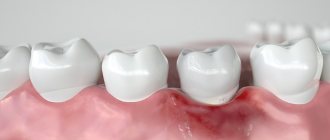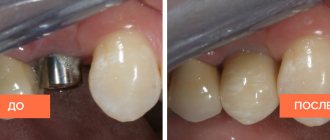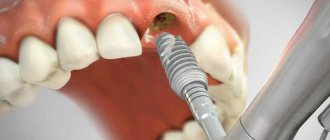Not all people manage to maintain the integrity of their dentition. As a rule, a tooth has to be removed in cases of advanced caries and periodontitis, root resorption, severe destruction of the coronal part, and grade III-IV mobility. A few months after extraction, dentists recommend installing an implant. It is necessary for the normal distribution of chewing load and restoration of smile aesthetics.
Dental implantation is one of the most effective ways to restore a lost tooth. Its essence lies in the implantation of an artificial root into the bone tissue, followed by fixation of the crown. This is a complex multi-stage operation, which should only be performed by highly qualified dentists. If implantation technology is not followed or low-quality structures are used, various complications are possible. Find out what signs indicate rod rejection and what measures need to be taken if the implant falls out or twists out of the gum.
Appearance of the gum former
The gum former looks like a thick screw with a small thread pitch. On its upper part there is a thick head. The diameter and shape of the upper surface of the head exactly corresponds to the base of the future tooth, and the lower part of the head, accordingly, has the shape of the top of an already installed artificial root. It turns out that the gum former exactly repeats the shape of the teeth and roots in their normal state.
The pin of the gum former has a thread that serves to screw it tightly into the artificial tooth root.
Gum formers are made individually and only for one specific tooth. This device is designed to form a hole in the gum where the artificial tooth will be located. The success of the installation of the gum former determines how tightly the artificial tooth will adhere to the gum. This is a very important point. The fact is that if the gum does not fit tightly around the tooth, then food will get into the gap. It is not so easy to remove it from there, and therefore gum inflammation is possible.
What is the gum abutment made of?
The best material for making a gum former is titanium. This metal is very light and extremely durable. In an aggressive environment, and the oral cavity is such for metal, titanium does not oxidize at all. In essence, this would be an ideal option for such a product, if not for one “but”.
The fact is that titanium is visible through the gum. For those people whose gums are visible when they smile, this option is not suitable. They prefer to install a healing abutment made of zirconium. This material does not have this drawback.
Classification
All gum formers are divided into three classes, depending on the type , shape and composition. These include:
- Premium They are made in Sweden and Switzerland. The main material is titanium.
- Business. Produced in Israel and Germany. The most commonly used are zirconium and titanium.
- Economy They are made in Korea or Israel from ceramics and plastic from zirconium.
6 effective methods for correcting deep bites
All products differ not only in composition, but also have a certain type of thread, shape and manufacturing technology.
When choosing a gum former, you should pay attention not only to its class and country of manufacture. Experts advise that all implants and other materials be supported by the same brand. Designs made in Israel are especially popular, as they have an affordable price and are distinguished by their quality.
Abutment and healing abutment
The technology of implanting artificial teeth along with gum formers allows the use of abutments. This is a completely different device, designed for installation in an artificial root after the gums have formed. It is installed in place of the gum former and serves to fit the tooth more tightly into the root.
The top of the abutment has a completely different shape than the healing abutment. It is made individually for each tooth. There are several types of abutments: temporary, standard, angled, cast and custom. These devices are made of ceramic, titanium, gold, plastic or special alloys.
Classification
In dentistry, it is customary to classify gum formers according to quality of manufacture and cost.
The economy class includes gum formers produced by Adin, Alpha Bio, MIS, Iterum (Israel), Bicon (USA), Implantium (Korea, USA).
Business class products are produced by the only German company in the world, Xive. Manufacturers of premium gum holders are Straumann (Switzerland), Astra tech (Sweden), Nico, Ankylos, Impro, Semandos (Germany), Nobel Biocare (USA).
Even though gum formers from one company are suitable for installing implants from other companies, dentists still recommend using all products from the same manufacturer.
Experts' opinion
Olga Soromokhina, dentist:
“If the gum former falls out, the patient is required to urgently go to the dental clinic to have it reinstalled. In case of delay, the implant begins to become overgrown with soft tissue, which will require a new dissection of the gum. If overgrowth occurs in the future, problems may arise with the installation of the external structural element - the crown.”
Igor Chernov, implantologist:
“Removing the implant while unscrewing the abutment with little force is, in most cases, the fault of the implantologist. If excessive force is applied, the blame for implant failure lies entirely with the orthopedic surgeon.”
Installation sequence
The length of time required to prepare for the placement of a healing abutment may vary. This depends on the extent of preparatory measures. Sometimes this process lasts for six months, and sometimes only for a few days. The operation itself does not last long. During a standard installation, it is done in the following sequence:
- - local anesthesia is given;
- — an incision is made in soft tissue to gain access to the fastening;
- - excess soft tissue is cut out;
- — the plug is removed from the implant;
- — manually or with a ratchet, screw the former into the root.
- - stitches are placed on the cuts.
How long do you have to wear a gum former?
After installation of the former, the gums usually heal within a week, but this does not happen in all patients. In any case, only the doctor determines the readiness of the oral cavity for surgery.
Separately, it is necessary to say about bleeding from the gums after installing the former. For most patients, this ends on the second or third day. However, for many, the ichor oozes for much longer. You shouldn’t be afraid of this, since these are simply individual characteristics of the body in terms of blood clotting. Statistics show that you have to wear a gum former for no longer than two weeks. After this, the former is unscrewed to take an impression for the prosthesis.
The essence of the formation of the hole is the flow of soft tissues around the gum former. Of course, they cannot adhere to the surface of the former, but they adhere to it very tightly. As a rule, this process occurs evenly along the entire circumference of the former. Only in rare cases does the overgrowth occur unevenly. In this case, surgical intervention is required.
Diagnosis and treatment
To determine why the implant twists or falls out of the gums, it is necessary to undergo a comprehensive diagnosis. It includes:
- visual examination in the dentist's chair,
- radiography,
- bacteriological analysis of a smear from the oral mucosa.
The specialist will determine the negative factor and tell you whether the implant can be saved or whether a repeat operation is necessary. The structure can be saved if the implant has not become loose and the bone tissue has not lost volume. In other cases, reimplantation is usually indicated.
Possible complications after the installation of a gum former
Unfortunately, the process of gum formation can be complicated by considerable troubles. Most often they are caused by a doctor’s error, less often by the characteristics of the patient’s body.
The doctor’s mistake is also considered to be the fact that he did not find out whether the patient is susceptible to an allergic reaction to painkillers. If such a reaction exists, then after installing the former in the patient’s oral cavity, an inflammatory process may begin. It should be said that the shaper itself cannot cause an allergic reaction.
Sometimes after installing the shaper, the pain does not disappear, but, on the contrary, intensifies. This is a sign of inflammation of the soft tissues or a violation of the tightness of the sutures. In this case, the patient is prescribed antibiotics and new sutures are placed. Sometimes swelling of the cheek occurs after surgery. This is not an anomaly, and the swelling soon goes away on its own.
It also happens that the former puts too much pressure on the gum, causing it to become inflamed. In this case, all the blame lies with the doctor, because he incorrectly calculated the size of the shaper. Such a former has to be replaced with another. It is very bad if the shaper begins to wobble a few days after installation. This can happen from a loose fit into the root or a loose fit of the artificial root into the bone. A loose root may be due to insufficient bone density. In this case, the doctor prescribes calcium for use. If the density of the bone tissue is high, and the former wobbles along with the root, it means that the body has not accepted the foreign body and rejects it. Soon an inflammatory process will begin under the root. To avoid this, the former is removed along with the root.
Sometimes the gums bleed for a long time under the stitches, although the stitches were applied correctly. There is only one reason for this: the patient’s weak blood clotting ability. In this case, you should definitely consult a doctor.
It is very important to know that if you do not follow all the doctor's recommendations, then in the postoperative period you may experience such unpleasant things as tumors, toothache, neck pain or sore throat and ear.
Is it possible to replace a lost dental implant?
If complications have become irreversible and it is not possible to save the prosthesis, the question of reimplantation arises. It includes:
- removal of the implant (if it has not completely fallen out);
- elimination of inflammation, disinfection of the wound channel, removal of pus (if necessary);
- rehabilitation period;
- taking medications;
- sinus lift (if necessary) - bone tissue augmentation;
- installation of a new implant.
The interval between the moment when a dental implant falls out and reimplantation is several months. At this time, the patient must carefully monitor the condition of the oral cavity, regularly perform all hygiene procedures, rinse with a medical solution and strictly follow all the recommendations of the dental surgeon.
According to statistics, the percentage of implant rejection is extremely small - only 1-5%, depending on the manufacturer, and the majority of them are due to the fault of the patients themselves, who violate the rules of the rehabilitation period. In general, implants take root quickly and delight their owners with a beautiful smile for many years.
What can happen if the healing abutment is not installed correctly?
Correct installation of the gum former is a guarantee that the implantation of an artificial tooth will be completed successfully because the socket for the prosthesis will be formed as needed. If the shaper is not installed accurately, then the hole will not be formed as it should be.
If the root is planted too deep into the bone, then the former will not be installed correctly. Soon it will begin to wobble and then fall out. This happens because bone tissue will begin to grow on the root and displace the former. In such a situation, the doctor cuts off the growth of bone tissue, and the structure will soon strengthen itself.
If the former suddenly falls out of the root, you need to immediately screw it into place yourself and see a doctor as quickly as possible. You cannot delay your visit, because the hole begins to overgrow very quickly. A late visit means that you will have to start installing the former again, which means cutting the gum again.
It also happens that the soft gum tissue completely covers the entire former. This is the result of a doctor’s mistake who incorrectly calculated the size of the shaper. In this case, you have to install a new, higher former. An incorrectly installed gum former that is too high causes discomfort when eating. This situation also requires replacing the former with a lower one.
Possible mistakes
If the structure is installed incorrectly, then after a few days discomfort, irritation, an allergic reaction or inflammation appears. Poor installation can also cause:
- The occurrence of discomfort while chewing food. It appears when the height of the part was selected incorrectly.
- falls out due to a loose fit to the artificial root.
- Complete or partial closure of the cap as a result of an incorrectly sized design.
Effective ways to correct your bite
All mistakes are corrected by the dentist. He can tighten or completely replace the shaper. It is important that the root implant is installed correctly. Minor inaccuracies can be corrected with an angled abutment. Unnecessary tissue is removed surgically with accelerated overgrowth. It is very important not to confuse edema and hyperplasia.
The former is screwed back in if it falls out so that the junction of the parts on the gum does not become overgrown.
How to care for your mouth after a gum former is installed?
After installing the gum former, you need to take care of your oral cavity in full, but in a gentle manner. The first thing we recommend is to change your hard toothbrush to a soft one. In this case, when brushing your teeth, you will not disturb the gums, and most importantly, the stitches. At this time, you need to brush your teeth without any pressure on the brush. If you want, you don’t need to clean them, but gently iron them. If the former suddenly falls out while brushing your teeth or eating, you should screw it back into place and immediately go to the doctor. Along with brushing your teeth, it is recommended to rinse your mouth with a saturated saline solution several times a day during the postoperative period. It is best to use sea or iodized salt. This procedure successfully prevents the occurrence of inflammatory processes.
A solution of hydrogen peroxide, tincture of calendula flowers, a decoction of echinacea root, a mixture of honey and salt, and some essential oils have similar properties.
Advice for pregnant women
In case of emergency, dental implantation can be done during pregnancy, but there are strict restrictions. So, this is strictly forbidden to do this in the first and third trimester, but in the second trimester it is possible. In this case, it is necessary to take into account the likelihood that after installing the gum former, the patient will have to take medications. This is not at all desirable for the fetus. The second point is that when installing a gum former, local anesthesia is used, and this will certainly affect the condition of the fetus. If it is possible to postpone implantation until the baby is born, then it is better to do just that.
What to do if the screw in the crown comes out
Loosening of a screw in an installed screw-retained crown can occur if:
- the crown had initially poor proximal contacts and the patient was able to unscrew the loose screw;
- there is loosening of the screw with initially good approximal contacts.
If there is rotation of an implant with a cement-fixed crown , there is one way to fix the problem - change the cement fixation to a screw one. In this case, it is necessary to provide access to the screw to create the shaft. This will require drilling a hole in the crown, but first you need to accurately calculate the projection of the screw head on the occlusal surface.
It is impossible to solve the problem of a loose screw on your own, so the patient needs to see a dentist.
How expensive is implantation?
In conclusion, let’s say a few words about the cost of dental implantation. The cost of this operation largely depends not on the cost of dental labor, but on the cost of the materials from which the implants are made. In addition, real prestige and the manufacturer’s own self-esteem bring their own adjustments to pricing.
Also, the price depends on the class of implants; the higher it is, the higher the price. The cost of implants from European manufacturers is much higher than that of their American and Australian counterparts.
The most inexpensive implants currently are Israeli ones.











